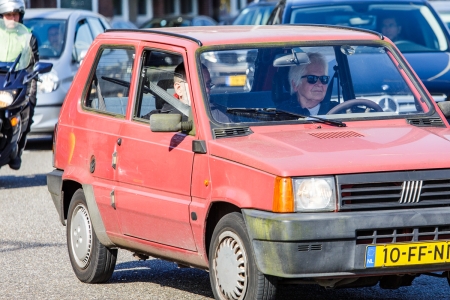Infrastructural measures
Assuming that the functional limitations become more frequent as one ages, it is important that for each task the road user has sufficient opportunity to detect, decide, and act. Furthermore, it is important to design the infrastructure in such a way that it conforms to the road users' expectations based on their experience. These preconditions are largely in line with the principles of a sustainably safe traffic system. That is why realising Sustainably Safe also benefits the safety of the elderly road user. Specific implementations, however, sometimes require a better tuning to the elderly road user. This means, for example, that:
- new designs must match existing principles so that the elderly can use their experience and existing automatisms;
- complex tasks can be performed in parts (e.g. crossing the road in phases), in which the elderly can repeatedly assess the situation from a safe place and can themselves determine the time pressure;
- important infrastructural features stand out, e.g. by good lighting and clear road markings.
Concrete examples of infrastructural adaptations while keeping the elderly in mind can be found in Staplin et al., (2001) and Davidse (2002). A summary of the information in these publications can be found in the archived SWOV Fact sheet The elderly and infrastructure. Furthermore, a CROW publication discusses a ‘senior proof’ road design (CROW, 2011) and the partnership ‘Blijf Veilig Mobiel’ (Remain Mobile Safely) has published a brochure with issues concerning a senior proof road design for cyclists (Blijf Veilig Mobiel, 2014).
Technical adaptations
The driving task can also be tuned to the road user's individual possibilities. For a long time now technical adaptations have been available such as power steering, an automatic gearbox, and adjustments of the power needed to press down the brake and/or acceleration pedal. These are systems that offer specific support for motor functional limitations, such as the decline in muscular strength. Also, more and more Intelligent Transport Systems (ITS) are becoming available which can assist the elderly motorist with functional limitations of vision, attention, and information processing. Examples are systems that warn about other vehicles simultaneously approaching an intersection, systems that help when merging or changing lane, and systems that project the relevant traffic signs and warnings along the roadside inside the vehicle. See also (the archived) SWOV Fact sheet The elderly and Intelligent Transport Systems (ITS)).
Protection devices
If, in spite of the above-mentioned measures, crashes still occur, protection devices such as bicycle helmets or technical vehicle measures can minimize the consequences. The application of airbag-like systems such as SIPS (Side Impact Protection Systems) can offer extra protection in side collisions, such as crashes when turning left in which the elderly are overrepresented.
Information, education, and testing
With a progressive decline in functions, adaptations to the road and vehicle surroundings cannot always prevent individuals becoming unfit to drive a vehicle. Therefore, a procedure that leads to a timely withdrawal from traffic is necessary. The problem is determining the threshold: when is someone still fit to drive and under which preconditions (vehicle adaptations, aids, training, limited driving licence)?
In addition, information meetings are important to inform the elderly about the functional limitations that come with aging, and the aids available to continue driving a car safely for as long as possible. In these meetings they should also learn about changes in traffic situations and rules, and about problem situations that they could come across and how to deal with them best (Davidse & Hoekstra, 2010). Such information meetings are best accompanied by a practical driving course such as the Dutch ‘BROEM’ drive for the elderly to test the driving skills, the mobility scooter course, or the course ‘Safely mobile’ for cyclists. The greatest challenge is to reach people who themselves have great doubts about their driving skills, and those who overestimate their driving skills. Both of these groups will be less inclined to participate in these courses, the first group because of the fear of losing their driving licence and the other because they are convinced that they do not need such a course.
Alternative transport possibilities
If, from a safety point of view, driving is no longer justified, the elderly must be supported in switching from the car to other modes of transport; for each target group the most suitable transport mode must be found. The availability of public transport is very important. As more of the elderly continue to live independently, and public transport is not always available nearby, it is important that door-to-door community transport is also available, particularly in rural areas. The co-operative ‘Remain Mobile Safely’ has developed a guide for advisors of the elderly which they can use for individual mobility advise. Based on what causes the reduced mobility, physical limitations, unfamiliarity with the vehicle, finances, these advisors can tell the elderly how they can re-establish their mobility. This can for instance be achieved by following a course, or by turning to the council to apply for a grant.
